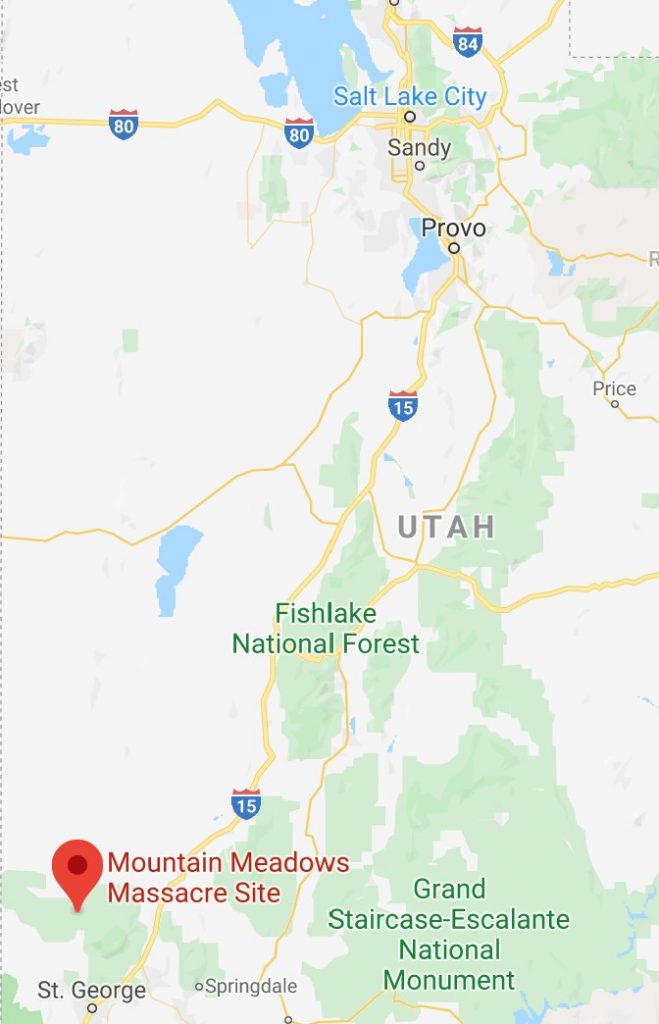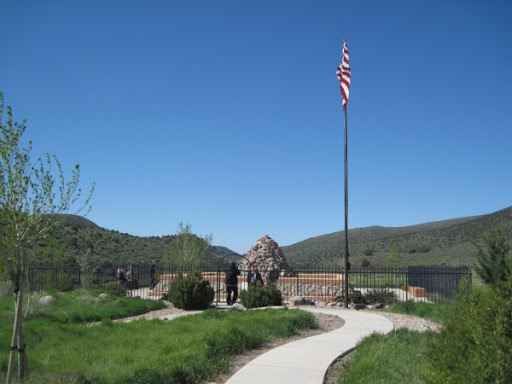Hey guys! We’re going to talk about something pretty heavy today. Historian Richard Turley summed up the issue well: “On September 11, 1857, some 50 to 60 local militiamen in southern Utah, aided by some American indian[s], massacred about 120 emigrants who were traveling by wagon to California. The horrific crime, which spared only 17 children aged six and under, occurred in a highland valley called the Mountain Meadows, roughly 35 miles southwest of Cedar City.”


We’re going to cover this issue in 2 parts. In this episode, we’re just going to talk about what happened. And in the next episode, we’ll talk about the aftermath of the event and we’ll answer some common questions. Queue the intro.
Latter-day Saints by 1857 were no strangers to persecution. They thought they’d be safe under their own system of government in Utah, which, at the time they settled there, was safely outside of the United States—until the Mexican-American War ended, and Utah was annexed. “The Saints drove out some federal appointees and sent a legislative message demanding greater control of the territory. Considering their actions rebellious, U.S. President James Buchanan sent a large part of the U.S. Army to seat and protect a new set of officers, including a non-Latter-day Saint governor to replace Brigham Young.” This marks the beginning of the “Utah War.”
Brigham Young and the Saints, recalling past maltreatment at the hands of some government officials on all levels, thought incoming soldiers meant an invasion, and they intended to fight back. Young instructed the Saints to stockpile their grain and other supplies in preparation for war, instead of trading goods out to emigrant trains passing through. That was understandably frustrating to an emigrant train that tried with little success to resupply in Cedar City.
Tensions ran high and a few emigrants made some idle threats against the Saints. Enter stage right: Isaac Haight, the mayor of Cedar City—also a militia major and stake president. “One account said that ‘cursing and ‘drunk’ men went to Haight’s house and demanded that he come out ‘if he was a man.’ The men also yelled threats about sending an army from California to seize Young, Haight, Dame [who we’ll meet in a moment] and ‘every other damn Mormon in the country.’”
Haight tried to have these men arrested for intoxication and disturbing the peace, but was forced to back down when he didn’t have enough policemen to carry out the order. So, Major Haight appealed to the district militia commander, William Dame (also a Stake President in nearby Parowan), for permission to call out the militia against the wagon train to make those arrests and likely charge some fines. Dame convened a council which told Haight to ignore the threats. “Words are but wind—they injure no one…”
But Haight and some others, angry and probably afraid, wouldn’t let things go, so they concocted a terrible, totally unjustifiable plan. With the help of militia major John D. Lee, they planned to rile up local Native Americans and have them attack the wagon train that had since left town. Under no one’s authority but their own, they set the wheels of their plan in motion.
On Sunday, September 6th, Haight again brought up the question of the wagon train at a local council meeting but withheld the fact that the cogs of his plan were already turning. The council decided a rider should be sent to Brigham Young to seek his advice on what to do, but it was too late. John D. Lee led the first attack on the emigrants on Monday morning.
The emigrant party circled the wagons and hunkered down for the siege. To make matters worse, there were 2 emigrants who had been off looking for lost cattle at the time of the attack. Two white militia leaders tracked them down and tried to kill them before they became privy to the situation and went for help. But one of the emigrants survived and made it back to the wagon circle. Now the emigrants knew that white men, Latter-day Saints, were involved in the attack.
The conspirators were faced with a haunting dilemma: If the party was allowed to live, they’d surely spread the word of the attack, which could bring the wrath of the United States down on them and their families. The other option was unimaginably evil: to kill everyone old enough to tell stories about what had happened. But to do that, they’d need more help from the militia. And for that, they’d need permission from the commanding officer, William Dame. Isaac Haight met in council with Dame and other Parowan leaders on Wednesday, September 9th.
The council decided to send the militia to help the emigrants gather their scattered cattle and continue on to California. But Haight met privately with Dame after the council hoping to reverse the decision. It’s not totally clear what happened at that meeting, but Haight left feeling like he had permission to call out the militia and deal the final blow, which he did.
On September 11th, under a white flag, John D. Lee convinced the emigrants to lay down their arms, promising that the militia would escort the party back to Cedar City. About a mile down the trail, at a pre-determined signal, the militiamen launched an attack in which everyone in the party, except 17 young children, was killed.
Two days later, the reply from Brigham Young arrived, which said, “In regard to emigration trains passing through our settlements, we must not interfere with them until they are first notified to keep away. You must not meddle with them … if those who are there will leave, let them go in peace.”
When Isaac Haight read the message, he reportedly sobbed, saying “Too late, too late.” Now, this has been a very brief description of this event. If you want to dive deeper, I highly recommend this book, which is extremely thorough. The Mountain Meadows Massacre was a shameful tragedy, and there are still lots of questions and conspiracy theories about this event that we’re going to look at in the next episode. Once that episode is up we’ll link it in the description. Check out those other links and notes below while you’re at it, and have a great day!
Learning More:
- Suspected Hofmann forgery of William Edwards affidavit?: https://bit.ly/2WSpX9I
- Collected materials concerning MMM (1859-1961): https://bit.ly/2JrgVsE
- Summary of issue from authors of book on this subject: https://bit.ly/2wNx0pF
- The Church’s gospel topics essay on this: https://bit.ly/2UsYM3E
- From the Encyclopedia of Mormonism: https://bit.ly/3dGeYq1
- Transcript of discussion on this topic between two scholars: https://bit.ly/2URdrF7
- Solid summary of event, from Church historian Richard Turley: https://bit.ly/2UOiF4o
- Fairmormon responses to questions on this subject: https://bit.ly/2QTbIOc
- Problems with MMM sources (Richard Turley): https://bit.ly/33UlQM3
- Timeline of events (of the Utah War): https://bit.ly/3avHzMD
